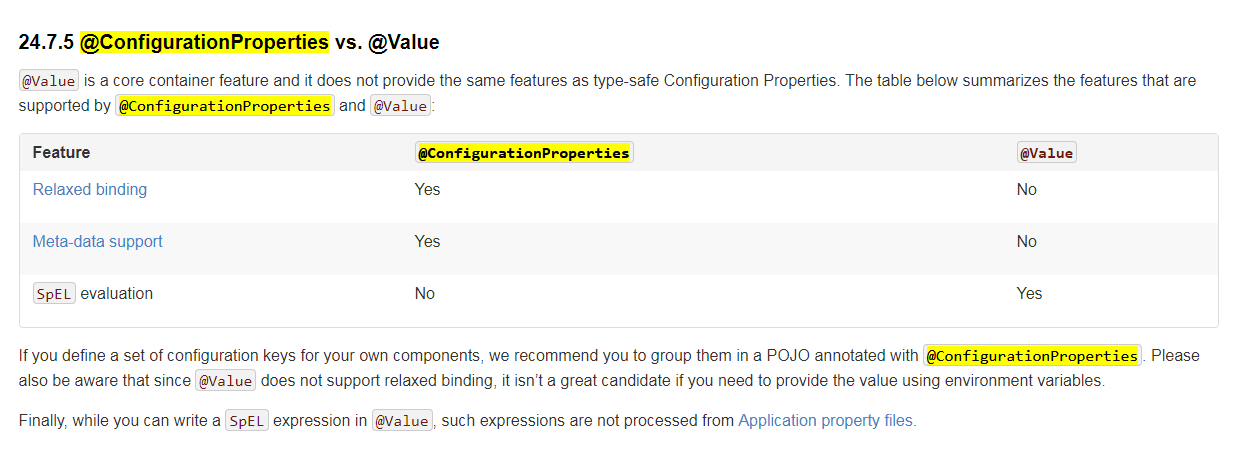在spring boot的使用中,通過@ConfigurationProperties 和 @Value 兩個註解可以給類賦值,但是兩個的使用方式還是有些不同的,以下是官方說明以及自己在使用中的簡介。
1.根據他們的比較你可以簡單的理解 :
-
1 鬆綁定:
@ConfigurationProperties使用中不必每個字都和配置中的key一致;@Value必須要一致 【可以理解成@ConfigurationProperties能夠批量注入配置文件的屬性,@Value只能一個個指定】
-
2 數據源支持 :
@ConfigurationProperties 還支持spring元數據,可以在resource下建立META-INF文件夾,然後建立文件additional-spring-configuration-metadata.json。裏面的數據格式必須滿足spring的元數據格式http://docs.spring.io/spring-boot/docs/1.5.3.RELEASE/reference/htmlsingle/#configuration-metadata
-
3 Spring表達式語言(SpEL):
@Value支持SqEL,簡單理解必須單個參數賦值,即強綁定。
- 4 @ConfigurationProperties還支持JSR303進行配置文件值及校驗【個人新增,官網沒體現】
2.實操說明
2.1Relaxed binding 鬆綁定
a.yml配置文件
#自定義 - 數據源配置
myconfig.dbconfig:
needUpdateScheme: true
dataUpdateType: prod #數據初始化類型 prod:只更新prod類型的init數據,test:更新所有類型的數據
databases:
db0:
url: jdbc:mysql://172.168.0.31:3306/xxx?useSSL=false&useUnicode=true&characterEncoding=utf-8
username: xxxx
password: xxxxb RepositoryProperties類爲配置文件的對象類,DatabaseProperty爲databases的對象類
@ConfigurationProperties(prefix = "myconfig.dbconfig")
public class RepositoryProperties {
//是否需要更新數據庫結構
private String needUpdateScheme = "false";
//數據源
private Map<String, DatabaseProperty> databases = new HashMap<>();
//數據初始化類型 prod:只更新prod類型的init數據,test:更新所有類型的數據
private String dataUpdateType = "prod";
public String getDataUpdateType() {
return dataUpdateType;
}
public Map<String, DatabaseProperty> getDatabases() {
return databases;
}
public String getNeedUpdateScheme() {
return needUpdateScheme;
}
public void setNeedUpdateScheme(String needUpdateScheme) {
this.needUpdateScheme = needUpdateScheme;
}
public void setDatabases(Map<String, DatabaseProperty> databases) {
this.databases = databases;
}
public void setDataUpdateType(String dataUpdateType) {
this.dataUpdateType = dataUpdateType;
}
} public class DatabaseProperty {
//連接串
@NotNull // ---
private String url;
//數據庫帳號
private String username;
//密碼
private String password;
public String getUrl() {
return url;
}
public void setUrl(String url) {
this.url = url;
}
public String getUsername() {
return username;
}
public void setUsername(String username) {
this.username = username;
}
public String getPassword() {
return password;
}
public void setPassword(String password) {
this.password = password;
}
} 2.2 Meta-data 元數據,Spring Boot jar 包含元數據文件,提供所有支持的配置屬性的詳細信息。這些文件旨在允許IDE開發人員在用戶使用application.properties 或application.yml文件時提供上下文幫助和“代碼完成” 。爲了改善用戶體驗並進一步協助用戶配置給定的屬性,您可以提供額外的元數據,在resource下建立META-INF文件夾,然後建立文件additional-spring-configuration-metadata.json,格式規範參考http://docs.spring.io/spring-boot/docs/1.5.3.RELEASE/reference/htmlsingle/#configuration-metadata。 【可參考 https://blog.csdn.net/L_Sail/article/details/70342023 ,這邊就不進一步深入,有興趣的童鞋可以嘗試,做一個自定義的Meta-data】
2.3 Spring表達式語言(SpEL)
public class RepositoryProperties {
//是否需要更新數據庫結構
@Value("${myconfig.dbconfig.needUpdateScheme}")
private String needUpdateScheme = "false";
......2.4 @ConfigurationProperties還支持JSR303進行配置文件值及校驗
@ConfigurationProperties(prefix = "myconfig.dbconfig")
public class RepositoryProperties {
@NotNull //JSR303進行配置文件值及校驗
private String needUpdateScheme = "false";
....
}

